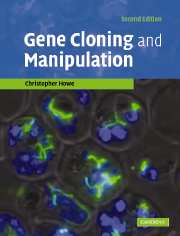Book contents
- Frontmatter
- Contents
- Preface to first edition
- Preface to second edition
- Chapter 1 The tools for the job
- Chapter 2 Polymerase chain reaction
- Chapter 3 Simple cloning
- Chapter 4 Other vector systems for E. coli
- Chapter 5 Making libraries
- Chapter 6 Screening libraries
- Chapter 7 Modification and mutagenesis
- Chapter 8 Use of cloned DNA
- Chapter 9 Using other organisms
- Chapter 10 Examples
- References
- Index
Chapter 2 - Polymerase chain reaction
Published online by Cambridge University Press: 05 June 2012
- Frontmatter
- Contents
- Preface to first edition
- Preface to second edition
- Chapter 1 The tools for the job
- Chapter 2 Polymerase chain reaction
- Chapter 3 Simple cloning
- Chapter 4 Other vector systems for E. coli
- Chapter 5 Making libraries
- Chapter 6 Screening libraries
- Chapter 7 Modification and mutagenesis
- Chapter 8 Use of cloned DNA
- Chapter 9 Using other organisms
- Chapter 10 Examples
- References
- Index
Summary
The basic technique
The method
Later chapters will describe the techniques for the amplification of DNA sequences by propagation inside cells. However, it is often possible to amplify specific sequences more simply and quickly by a direct enzymatic process called the polymerase chain reaction or PCR. The basic procedure is outlined in Figure 2.1. In the simplest case, PCR amplification requires that we know a small amount of nucleotide sequence at each end of the region to be amplified. Oligonucleotides complementary to that sequence are synthesized, typically 20 or so nucleotides long. These oligonucleotides are used as primers for enzymatic amplification.
A reaction mixture is set up containing a sample of DNA that includes the region to be amplified, the primers in large molar excess, deoxynucleoside triphosphates (dNTPs) and a heat-stable DNA polymerase. The most common enzyme for this purpose is the Taq polymerase, which is a DNA polymerase isolated from the thermophilic bacterium Thermus aquaticus, which can be grown routinely in the laboratory at 75°C or more. This enzyme, which the bacterium uses for cellular DNA synthesis, has a temperature optimum of at least 80°C and is not readily denatured by the repeated heating and cooling cycles that we shall see are needed in the amplification process. There are many other thermophilic bacteria, and their polymerases can also be used, as discussed below.
- Type
- Chapter
- Information
- Gene Cloning and Manipulation , pp. 30 - 51Publisher: Cambridge University PressPrint publication year: 2007



